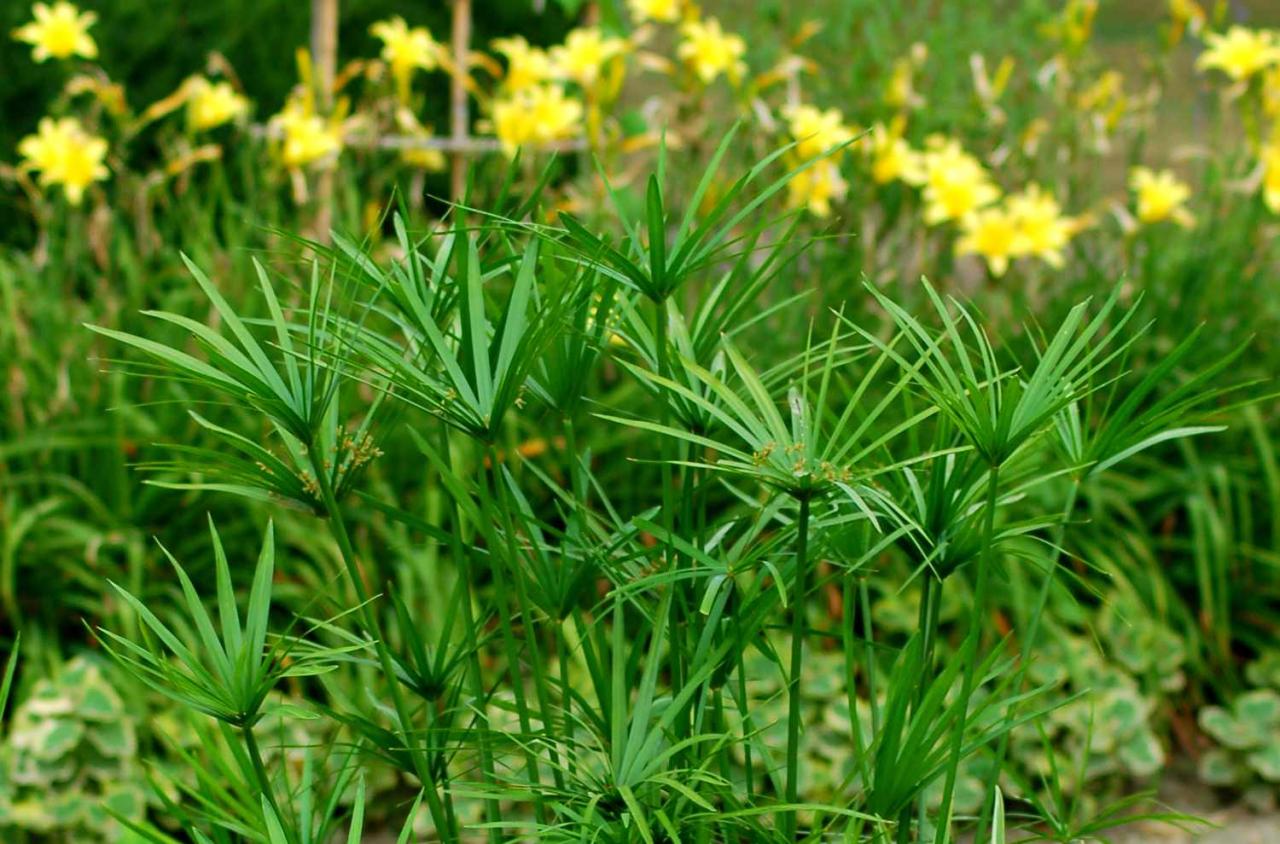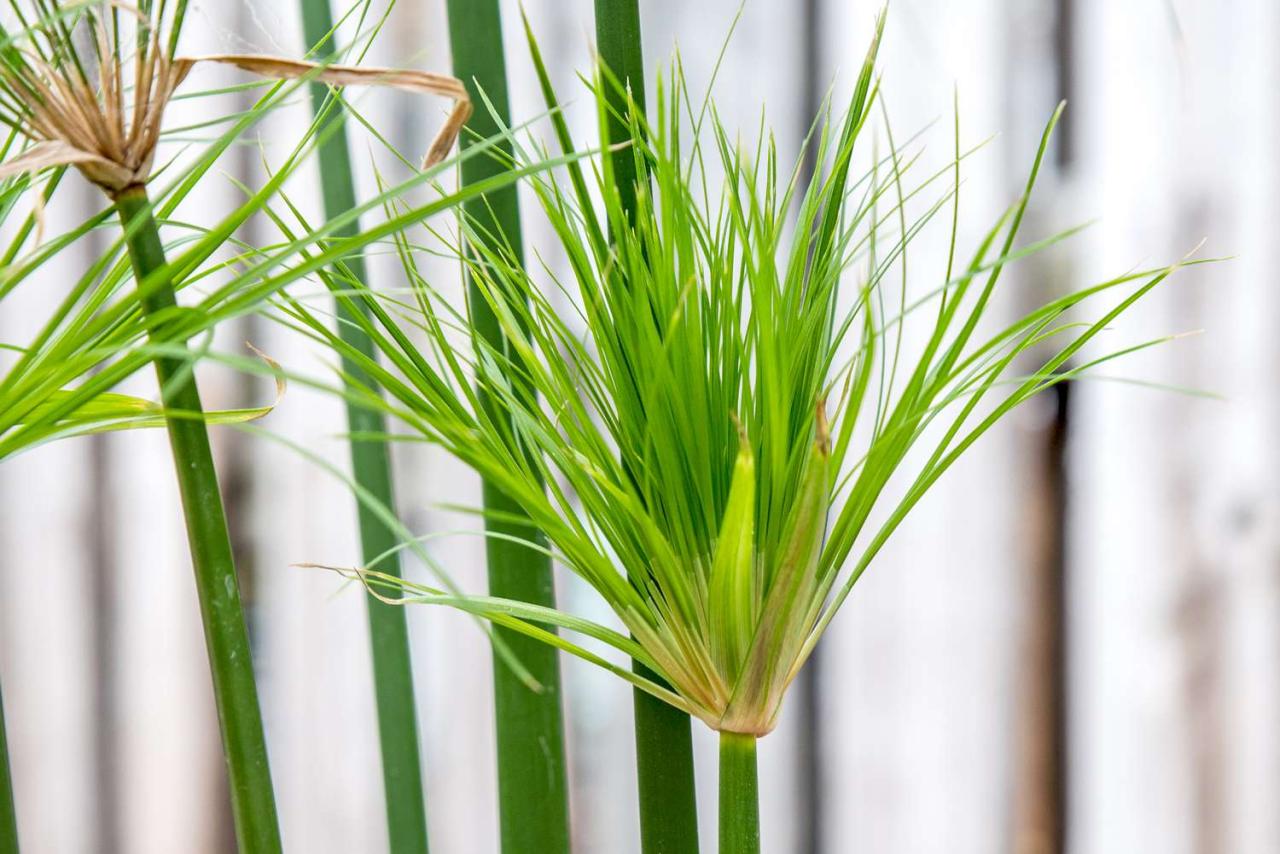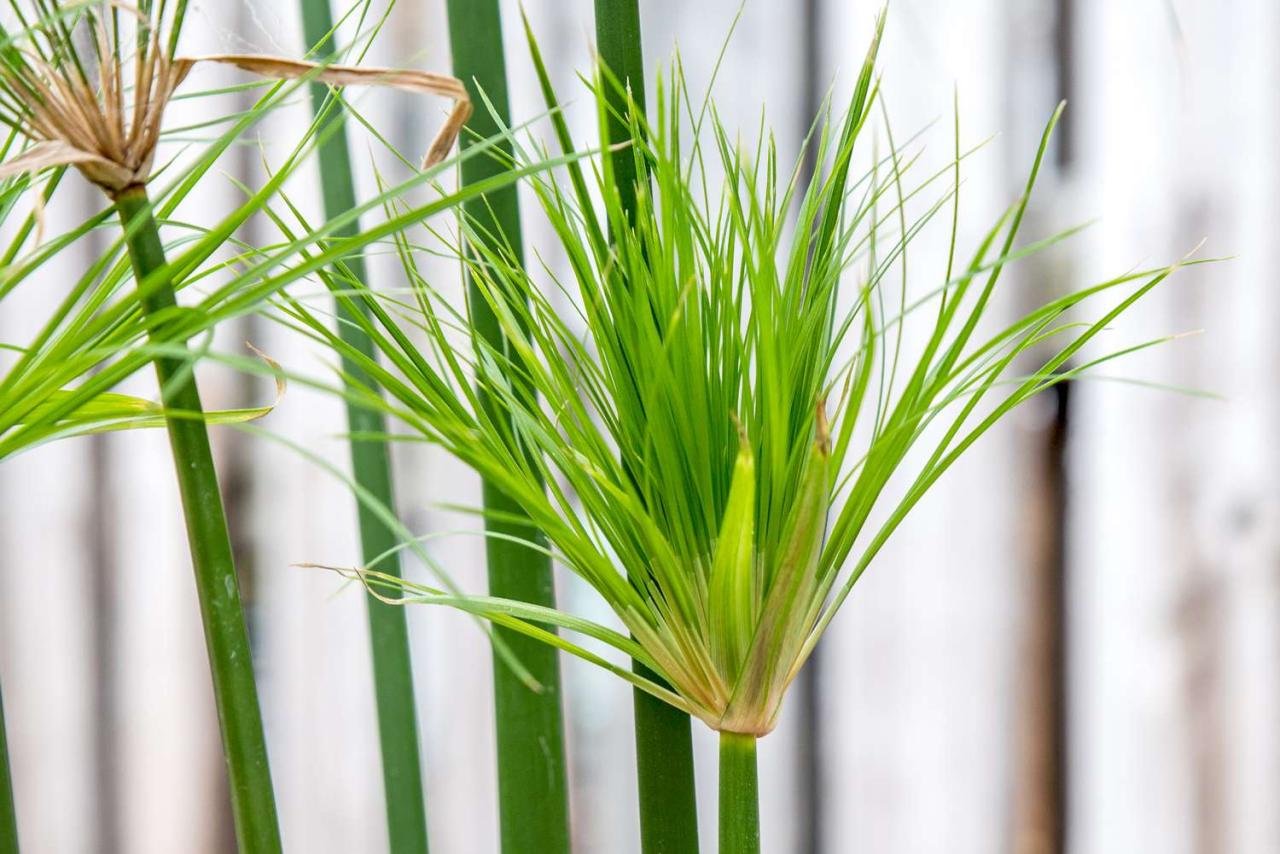How to Grow and Use Papyrus Plant: Tips for an Exotic and Stunning Garden sets the stage for this enthralling narrative, offering readers a glimpse into a story that is rich in detail with search engine journal author style and brimming with originality from the outset.
Imagine transforming your garden into a captivating oasis, reminiscent of ancient Egypt, with the majestic papyrus plant as its centerpiece. These remarkable plants, with their towering stalks and feathery plumes, possess a unique allure that transcends time and culture.
Papyrus plants, native to the marshlands of Africa, have long been admired for their historical significance and captivating beauty. Used for centuries in ancient Egypt for papermaking, writing, and religious ceremonies, these plants continue to inspire awe and fascination.
Their distinctive features, including their tall, upright stems and clusters of feathery leaves, add a touch of exotic charm to any garden setting.
Introduction to Papyrus Plants
Papyrus plants, with their towering stalks and feathery plumes, have captivated people for millennia. These ancient plants, native to the wetlands of Africa, played a pivotal role in the history of civilization, particularly in ancient Egypt. Beyond their historical significance, papyrus plants offer a unique aesthetic appeal, adding an exotic touch to any garden.
Historical Significance and Cultural Relevance
Papyrus plants hold a significant place in history, particularly in ancient Egypt. The Egyptians used the plant’s stalks to create a durable writing material, known as “papyrus,” which revolutionized communication and record-keeping. Papyrus scrolls were used to record religious texts, legal documents, and literary works, providing invaluable insights into ancient Egyptian culture and civilization.
Botanical Characteristics
Papyrus plants, scientifically known asCyperus papyrus*, are perennial sedges that thrive in moist, tropical environments. They are characterized by their tall, triangular stalks that can reach heights of 10 to 15 feet, resembling a cluster of elegant, green spears. The stalks are topped with feathery, umbrella-shaped flower clusters, which give the plant its distinctive appearance.
Growth Habits and Native Habitat
Papyrus plants are naturally found in wetlands, swamps, and along the banks of rivers and lakes in tropical and subtropical regions of Africa, particularly in the Nile Valley. They require plenty of sunlight and moist soil to flourish. These plants spread rapidly through underground rhizomes, forming dense clumps that can quickly fill a garden space.
Unique Qualities of Papyrus Plants
Papyrus plants possess a unique charm that sets them apart from other garden plants. Their towering stalks and feathery plumes create a dramatic and tropical ambiance, adding a touch of exoticism to any landscape. The plants’ ability to thrive in wet environments makes them ideal for water gardens, ponds, and boggy areas.
They can also be grown in containers, allowing them to be enjoyed in a variety of settings.
Growing Papyrus Plants
Papyrus plants thrive in warm, humid environments similar to their native African swamps. Understanding their ideal growing conditions is crucial for successfully cultivating these exotic plants. This section explores the optimal sunlight, soil, and water requirements for papyrus plants, providing guidance for achieving healthy growth.
Sunlight Requirements
Papyrus plants require ample sunlight to flourish. They prefer full sun to partial shade, ideally receiving at least six hours of direct sunlight daily. Insufficient sunlight can lead to stunted growth and pale foliage. In regions with intense summer sun, providing some afternoon shade may be beneficial to prevent scorching.
Soil Preferences
Papyrus plants thrive in moist, well-drained soils. They prefer soils rich in organic matter, which provides essential nutrients and improves drainage. A mixture of potting soil, compost, and peat moss is ideal. Avoid heavy clay soils that can retain excess water, leading to root rot.
Water Needs
Papyrus plants are highly water-demanding. They require consistently moist soil, particularly during the growing season. The soil should never be allowed to completely dry out. Regular watering, ideally every 2-3 days, is essential. In hot and dry weather, more frequent watering may be necessary.
Propagating Papyrus Plants
Propagating papyrus plants is a straightforward process that can be achieved through seeds, cuttings, or divisions. Each method offers advantages and considerations for successful propagation.
Propagation from Seeds, How to Grow and Use Papyrus Plant: Tips for an Exotic and Stunning Garden
Papyrus seeds are readily available online and at garden centers. Sow seeds in a seed tray filled with moist seed-starting mix. Maintain a warm temperature (around 70-75°F) and consistently moist soil. Germination typically takes 2-4 weeks. Once seedlings have developed a few true leaves, transplant them into individual pots.
Adding a touch of the exotic to your garden with the papyrus plant can transform your outdoor space into a tropical oasis. While papyrus thrives in wet environments, you can also add a splash of vibrant color to your culinary creations with the versatile perilla leaf.
Learn all about incorporating this unique herb into your dishes in The Ultimate Guide to Using Perilla Leaf in Your Cooking: Expert Advice and Tips , and then return to your papyrus garden, ready to create an even more captivating and fragrant haven.
Propagation from Cuttings
Stem cuttings are another effective method for propagating papyrus plants. Take cuttings from healthy, mature stems, ensuring each cutting has at least 3-4 nodes. Remove the leaves from the bottom node and dip the cut end in rooting hormone. Plant the cuttings in a pot filled with moist rooting mix.
Keep the cuttings in a warm, humid environment, and mist regularly to maintain moisture. Roots will typically develop within 4-6 weeks.
Propagation from Divisions
Dividing established papyrus plants is a simple and efficient way to create new plants. Gently dig up the plant and carefully separate the root ball into multiple divisions. Ensure each division has healthy roots and foliage. Repot the divisions in individual pots filled with fresh potting mix.
Transplanting Papyrus Plants
Transplanting papyrus plants is best done in the spring or early summer when temperatures are mild. Choose a location with full sun to partial shade and well-drained soil. Dig a hole slightly larger than the root ball and amend the soil with compost or peat moss.
Gently remove the plant from its container, loosen the roots, and place it in the hole. Backfill the hole with soil, firming it gently around the plant. Water thoroughly to settle the roots.
Caring for Papyrus Plants
Papyrus plants, with their striking resemblance to ancient scrolls, are relatively low-maintenance, but they thrive with consistent care. To ensure your papyrus plant flourishes and continues to grace your garden with its unique charm, consider the following tips for optimal care.
Fertilization
Fertilizing your papyrus plant is crucial for its healthy growth and development. Papyrus plants are heavy feeders, requiring regular nutrient replenishment. A balanced liquid fertilizer diluted to half strength should be applied every two weeks during the growing season, from spring to early fall.
During the winter months, reduce fertilization to once a month to accommodate the plant’s slower growth rate.
Pruning
Pruning your papyrus plant helps maintain its shape and encourages bushier growth. Dead or damaged leaves should be removed promptly to prevent disease and promote healthy growth. To maintain a desired height, you can trim back the tallest stems to encourage the plant to grow outward.
Pest Control
Papyrus plants are generally resistant to pests, but they can occasionally attract common garden pests like aphids, mealybugs, and spider mites. Regularly inspect your plant for signs of infestation, such as discolored leaves, sticky residues, or webbing. If you notice any pests, use a mild insecticidal soap or neem oil spray to control the infestation.
Protecting from Frost
Papyrus plants are not frost-tolerant and can suffer significant damage or even die if exposed to freezing temperatures. In regions with cold winters, it’s essential to protect your papyrus plant from frost. During the winter months, you can bring your plant indoors or move it to a protected location outdoors, such as a garage or shed.
If you choose to leave your plant outdoors, cover it with a frost blanket or burlap sack to insulate it from the cold.
While papyrus thrives in moist environments, a well-maintained lawn can complement its exotic beauty. For a lush backdrop, learn how to time your grass seed sowing for a thriving and vibrant lawn , ensuring a healthy green expanse that contrasts beautifully with the papyrus’s dramatic foliage.
With proper care, your papyrus plant will flourish, adding a touch of ancient Egypt to your garden landscape.
Common Challenges
While papyrus plants are generally hardy, they can face a few common challenges. Here are some common problems and solutions:
- Yellowing Leaves: Yellowing leaves often indicate overwatering, underwatering, or nutrient deficiency. Check the soil moisture levels and adjust watering accordingly. If the soil is consistently dry, increase watering frequency. If the soil is consistently wet, reduce watering frequency and improve drainage.
You can also try fertilizing the plant with a balanced liquid fertilizer to address potential nutrient deficiencies.
- Brown Leaf Tips: Brown leaf tips are usually caused by low humidity or excessive dryness. Increase humidity around the plant by placing a humidifier nearby or grouping the plant with other plants. You can also mist the plant regularly to increase humidity.
- Stunted Growth: Stunted growth can be caused by insufficient light, inadequate fertilization, or pests. Ensure your papyrus plant receives adequate sunlight, fertilize regularly, and check for pests.
Creative Uses of Papyrus Plants in Gardens: How To Grow And Use Papyrus Plant: Tips For An Exotic And Stunning Garden

Papyrus plants offer a unique and versatile element for garden design, adding a touch of exotic charm and visual intrigue. Their tall, graceful stems and feathery foliage create a sense of drama and grandeur, while their water-loving nature makes them ideal for a variety of settings.
Papyrus Plants as Focal Points
Papyrus plants can serve as striking focal points in gardens, drawing attention and adding visual interest. Their dramatic silhouette and texture create a sense of depth and dimension, especially when planted in groups or against a backdrop of contrasting foliage.
- Island Feature:Planting a group of papyrus plants in the center of a small pond or water feature creates a captivating island effect, drawing the eye towards the center of the garden. The feathery foliage provides a soft, textural contrast to the water’s surface.
- Solitary Statement:A single, tall papyrus plant can stand out dramatically against a backdrop of low-growing shrubs or flowering plants. Its vertical form adds height and interest to the landscape, creating a sense of balance and visual rhythm.
- Container Planting:Papyrus plants can be grown in large containers, making them ideal for patios, decks, or even indoor spaces with sufficient sunlight. The containers can be placed strategically throughout the garden, adding visual interest and a touch of exotic charm.
Papyrus Plants as Borders
Papyrus plants can be used to create borders that add visual interest and define garden spaces. Their tall, slender stems create a natural fence effect, while their feathery foliage softens the edges of the border and provides a sense of movement.
- Water Garden Borders:Planting papyrus plants along the edges of a pond or water feature creates a natural border that blends seamlessly with the aquatic environment. The plants’ water-loving nature makes them ideal for this application, while their tall stems provide a sense of privacy and enclosure.
- Informal Borders:Papyrus plants can be used to create informal borders around flower beds or vegetable gardens. Their graceful foliage and upright stems create a soft, natural boundary that complements a variety of planting styles.
Papyrus Plants in Water Features
Papyrus plants are naturally suited to water features, adding a touch of tropical beauty and providing habitat for wildlife. Their water-loving nature allows them to thrive in ponds, fountains, and even small water gardens.
- Pond Edges:Planting papyrus plants along the edges of a pond creates a natural, lush border that blends seamlessly with the aquatic environment. Their tall stems provide a sense of privacy and enclosure, while their feathery foliage provides a soft, textural contrast to the water’s surface.
- Fountains and Waterfalls:Papyrus plants can be planted around fountains and waterfalls, adding a touch of tropical charm and softening the sound of the water. Their feathery foliage provides a natural backdrop for the cascading water, creating a serene and relaxing atmosphere.
- Water Gardens:Papyrus plants are essential elements in water gardens, adding height, texture, and visual interest. Their water-loving nature allows them to thrive in these environments, while their tall stems provide shelter for aquatic life.
Papyrus Plants with Other Exotic Species
Papyrus plants can be combined with other exotic or complementary plant species to create visually appealing and harmonious garden designs. The combination of textures, colors, and forms can enhance the overall impact and create a sense of unity and balance.
- Tropical Companions:Papyrus plants pair well with other tropical plants, such as canna lilies, elephant ears, and ginger plants. These plants share similar growing conditions and create a lush, tropical atmosphere.
- Water-Loving Companions:Papyrus plants can be combined with other water-loving plants, such as water lilies, lotus flowers, and water hyacinths. These plants create a vibrant, aquatic display that complements the papyrus’s graceful form.
- Contrasting Foliage:Papyrus plants can be combined with plants that have contrasting foliage, such as ferns, hostas, and Japanese maples. The contrasting textures and colors create visual interest and add depth to the garden design.
Papyrus Plants and Wildlife
Papyrus plants attract a variety of wildlife, including birds, butterflies, and dragonflies. Their feathery foliage provides shelter and nesting sites for birds, while their tall stems offer perches for observing the surrounding environment.
- Bird Habitat:The dense foliage of papyrus plants provides shelter and nesting sites for birds, such as warblers, sparrows, and finches. The plants’ tall stems also offer perches for observing the surrounding environment.
- Butterfly and Dragonfly Habitat:The feathery foliage of papyrus plants attracts butterflies and dragonflies, which use the plants for shelter and food. The plants’ tall stems provide perches for these insects, allowing them to survey the surrounding area for nectar and mates.
Closing Notes

By embracing the tips and insights shared in this guide, you can unlock the secrets of cultivating these captivating plants and transform your garden into a stunning testament to the wonders of nature. Whether you’re a seasoned gardener or a curious beginner, the journey of growing papyrus plants is sure to be an enriching and rewarding experience.
So, let the allure of the papyrus plant guide you as you embark on this botanical adventure, and watch as your garden flourishes with the exotic beauty of these remarkable plants.
FAQ Compilation
Can I grow papyrus plants indoors?
Yes, papyrus plants can be grown indoors in a bright, sunny location. However, they require ample humidity and regular watering to thrive.
What are the best companion plants for papyrus?
Papyrus plants pair well with other water-loving plants like water lilies, lotus flowers, and cattails.
How do I know if my papyrus plant is getting enough water?
The soil should always be moist, but not waterlogged. If the leaves start to brown or droop, the plant may be dehydrated.
